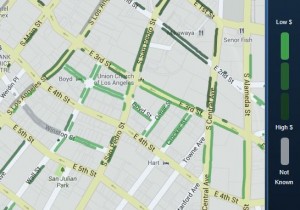In May Richmond City Council voted to increase the hourly rate for street parking downtown from $.50 to $.75 per hour with the goals of netting an additional $250,000 yearly in revenue and helping downtown businesses by increasing the turnover in parking spaces. By way of market research, according to the Times-Dispatch, city officials had surveyed ten other comparably sized cities and found that Richmond’s hourly rate was lower than any other.
Think about that: City council acted based upon the experience of other cities rather than upon any insight into local supply and demand conditions. Furthermore, by setting a uniform rate for the central business district, Council almost ensured that the rate will be too high in some locations and too low in others.
There’s no excuse for such ill-informed decision making and such one-size-fits-all parking policies anymore. New technologies are making it possible to adjust parking prices based on street-level changes in supply and demand in order to ensure optimal results. If Richmond wants to remain a competitive business location, it needs to explore such “smart cities” technologies more aggressively.
To get a better sense of state-of-the-art thinking in the parking world, I chatted last week with David Cummins, vice president-parking solutions for Xerox Corp. Xerox was the systems integrator behind L.A. Express Park, an $18.5 million overhaul of on-street parking in downtown Los Angeles.
The parking meter was introduced in Oklahoma City in 1935 and parking technology barely changed until the late 2000s, says Cummins. Then all hell broke loose. He counts at least 20 new technologies and innovations that are roiling the world of parking. Indeed, he asserts, “Parking has been the most innovative of all the transportation sectors in the past five years.”
Xerox parking systems can help cities boost ticket collections, if that’s their goal, by installing sensors in parking spaces, notifying meter enforcers and even optimizing their routes. But Xerox also can help cities make parking a more pleasant experience that makes people more comfortable doing business downtown.
Says Cummins: “Parking is a painful process, from the moment you think about where you’re going, to looking for empty parking spaces, understanding the signage, figuring out if you have enough coins in the glove box, going to a restaurant and having anxiety over whether you’ll have a ticket on your car when you get back. Our goal is to take the pain out of parking … to make parking a non-event.”
The key feature of L.A. Express Park is dynamic pricing that varies block by block. The goal is to keep street parking spaces between 75% and 90% full. If occupancy drops below 75%, Xerox’s proprietary algorithm drops hourly rates to encourage more people to park on the street. If occupancy exceeds 90%, the system raises rates. The algorithm recognizes seasonal and time-of-day variations as well as spillover effects from one part of downtown to another.
It is critical, says Cummins, for people always to be able to find an open space. Otherwise, they will cruise around looking for one, contributing significantly to traffic congestion. “Parking is tightly integrated with congestion. If you have parking congestion, you will have street congestion.”
In L.A., apps such as Parker, Parkme and ParkMobile allow drivers to locate empty spaces and compare prices for street, lot and garage parking. New pay-by-phone and other payment systems make it easier than ever to pay for parking, “feed” the parking meter remotely and, if necessary, pay parking fines.
Xerox stores all the parking data in a data warehouse. “As you build your data over time, your algorithms get better,” Cummins says. Xerox mines that data to recommend performance-enhancing tweaks to the system.
While L.A. is a pace setter in smart parking, Cummins predicts the technologies will spread. As citizens see the system at work in L.A., San Francisco, Washington or Indianapolis, they will demand the same convenience in their own cities. Retrofitting an entire downtown can run into the millions of dollars; a federal grant covered most of the cost of L.A’s pilot project. One way other cities may be able to justify the investment based is through improved ticket collections. The City of Los Angeles was hoping in 2012 to boost parking-ticket collections by $8.4 million yearly.
Admittedly, writing more tickets is not calculated to engender warm and fuzzy feelings for your downtown. But Xerox contends that new technologies also can drive down the cost of enforcement and billing. Ideally, in my book, those administrative savings would finance the smart-parking upgrade, giving a municipality what amount to free tools to manage its parking assets more effectively.
In closing, I asked Cummins if he sees “smart parking” as a natural adjunct to “smart growth.” It’s a possibility, he says. “From our perspective we’re making more livable and sustainable communities” by optimizing parking space utilization, reducing parking congestion and, by extension, reducing traffic congestion and pollution. Some people think that anything that makes parking and driving more attractive is counter to smart growth goals such as walkability and mass transit. But Cummins is confident smart parking can advance smart-growth priorities like car sharing and bike sharing.
A conservative philosophy of smart growth, like that espoused by Bacon’s Rebellion, recognizes that automobiles and parking are likely to remain part of the urban fabric for a long time. Smart growth thinkers should jump on parking technologies like those used in L.A. Express Park to advance their vision.



